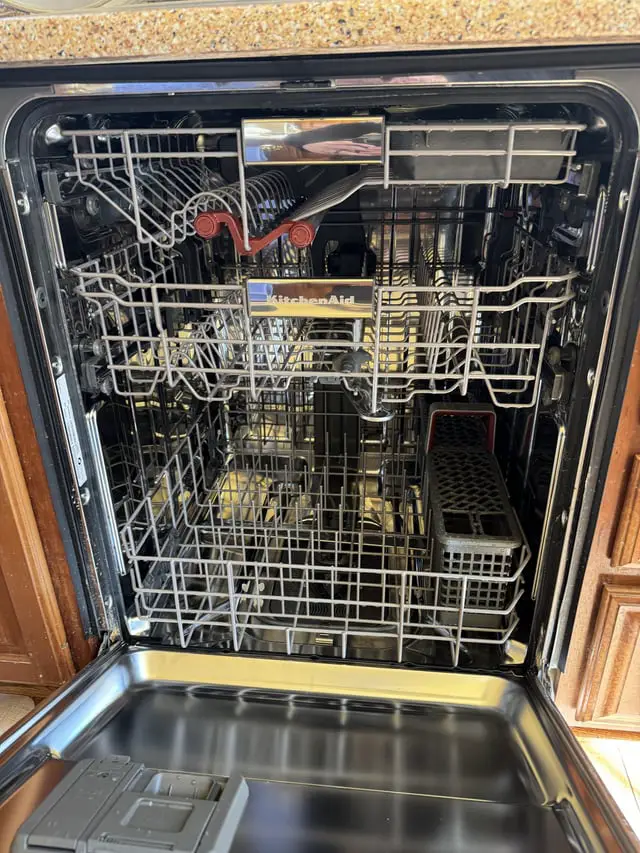Continental Refrigerator Troubleshooting: Quick Fixes Guide
Are you tired of dealing with a refrigerator that just won’t cooperate? Whether it’s warm spots or strange noises, a malfunctioning fridge can be more than just an inconvenience—it can disrupt your daily routine and potentially spoil your food.
If you own a Continental Refrigerator, you’re in luck. These appliances are known for their reliability, but like any other machine, they can occasionally run into problems. The good news is, many of these issues can be resolved with a little troubleshooting, saving you both time and money.
In this guide, we’ll walk you through common problems and their solutions, empowering you to get your fridge back in top shape. So, if you’re ready to tackle the issues head-on and reclaim your peace of mind, keep reading.

Credit: www.webstaurantstore.com
Common Issues
Dealing with refrigerator issues can be frustrating, especially when they disrupt your daily routine. Continental refrigerators, known for their durability, can sometimes present common problems that need quick attention. Understanding these issues can save you time and help maintain your refrigerator’s efficiency. Let’s dive into some of the most frequent challenges you might face.
Temperature Fluctuations
One morning, you might find your milk warmer than expected. Temperature fluctuations in your Continental refrigerator can result from a few causes. Check if the thermostat is set correctly. Sometimes, a simple adjustment can make all the difference.
Another culprit could be an overstuffed fridge. Ensure there’s space for air circulation. If you notice persistent issues, it could be a faulty temperature sensor. Consider a replacement to keep your perishables fresh.
Unusual Noises
Ever heard your refrigerator sounding like a vintage car? Unusual noises can be alarming. These sounds often come from the compressor or fan. Make sure they aren’t blocked or dirty. A good cleaning might resolve the issue.
Loose parts might also cause rattling sounds. Inspect and tighten any loose screws or panels. You could save yourself a costly repair by simply tightening a screw.
Water Leaks
Noticed a puddle forming under your fridge? Water leaks are more common than you think. Often, it’s due to a blocked defrost drain. Clear it out to prevent future leaks.
Check the door seals for damage. A poor seal allows warm air in, causing condensation and leaks. You might need to replace the seal to keep your kitchen dry and tidy.
Have you encountered any of these issues? Knowing how to address them can turn a frustrating situation into a manageable task. Take a proactive approach, and your Continental refrigerator will continue to serve you well. What’s your biggest refrigerator challenge?
Temperature Problems
Facing temperature issues with your Continental Refrigerator? Discover quick troubleshooting tips to maintain optimal cooling. Identify common causes like blocked vents or faulty thermostats to ensure efficient operation. Stay informed to protect your stored goods effectively.
Temperature problems in your Continental Refrigerator can impact food safety. They can also increase energy costs. Identifying the root cause is essential. It ensures your refrigerator operates efficiently. Below, we explore some common troubleshooting steps.Checking Thermostat Settings
Begin with the thermostat settings. Incorrect settings can cause temperature fluctuations. Locate the thermostat inside the refrigerator. Set it to the recommended temperature. Usually between 35°F and 38°F for refrigerators. Adjust the setting if necessary. Wait a few hours to see changes. If the problem persists, consider replacing the thermostat.Inspecting Door Seals
Door seals play a crucial role in maintaining temperature. Worn or damaged seals let cold air escape. Check the seals for any signs of wear. Look for cracks or gaps. Close the refrigerator door on a piece of paper. Try pulling the paper out. If it slides easily, the seal might need replacing. Properly sealed doors help maintain consistent temperatures.Cleaning Condenser Coils
Dirty condenser coils can affect cooling efficiency. They lead to higher energy consumption. Locate the coils at the back or bottom of the refrigerator. Disconnect the power before cleaning. Use a coil brush to remove dust and debris. Vacuum the area to ensure cleanliness. Regular cleaning keeps your refrigerator running smoothly. It also helps maintain the desired temperature.Noise Troubleshooting
Experiencing noise from a Continental refrigerator can be bothersome. Identifying the source helps in resolving issues quickly. Common culprits include fans, compressors, or loose parts. Regular maintenance ensures smooth operation and reduces disruptive sounds.
Is your Continental refrigerator making unusual noises? You’re not alone. Many owners experience this, and thankfully, there are simple fixes. Addressing these noises can improve performance and extend the life of your appliance. Let’s dive into noise troubleshooting and help you achieve a quieter kitchen.Identifying Source Of Noise
First, pinpoint where the noise is coming from. Is it inside the fridge or at the back? Different noises indicate different issues. Listen closely: a rattling sound might suggest a loose component, while a humming noise could be the compressor. Sometimes, a noise may stem from items inside. Ensure nothing is vibrating against the walls. If you can narrow down the source, you’re halfway to solving the problem.Leveling The Refrigerator
An uneven fridge can cause vibrations and noise. Use a level to check if your refrigerator is balanced. Adjust the legs by twisting them to raise or lower the fridge as needed. A stable fridge not only reduces noise but also runs more efficiently. You might be surprised how much difference a simple adjustment makes.Inspecting The Fan
The fan is a common culprit for noise. Over time, dust and debris can cause it to make odd sounds. Unplug your refrigerator and locate the fan, usually at the back or near the bottom. Carefully clean any visible debris. If the fan blades are damaged or loose, they may need replacement. Ensuring your fan is in good condition can drastically reduce noise levels. Have you ever tackled a noisy fridge? What was your experience like? Your insights could help others in the same boat.Addressing Water Leaks
Water leaks in Continental Refrigerators often stem from clogged drain lines or faulty seals. Identifying and addressing these issues ensures efficient operation and prevents costly repairs. Regular maintenance helps keep your refrigerator running smoothly.
Addressing water leaks in your Continental refrigerator can be a straightforward task with the right approach. Water leaks might seem like a small nuisance, but they can lead to bigger problems if left unattended. Knowing where to look and what to fix can save you both time and money. Dive into the troubleshooting process and tackle those pesky leaks with confidence.Examining Drain Pan
Start by locating the drain pan, typically found at the bottom of your refrigerator. This pan collects excess water that drips down from the fridge. If it’s overflowing, it might be due to a cracked pan or excessive water accumulation. Inspect the pan carefully. Look for any cracks or signs of wear. A damaged pan needs replacement to prevent further leaks. Ensure the pan is properly seated. Sometimes, a simple repositioning can stop the leak.Clearing Drain Line
A clogged drain line is a common culprit for leaks. This line channels water from the fridge to the drain pan. Use a thin, flexible wire to gently clear any blockages. You might be surprised at how much debris can accumulate over time. Pour a small amount of warm water mixed with baking soda through the line. This can help dissolve any stubborn clogs. Have you noticed the water flowing freely now?Checking Water Supply Line
The water supply line is essential, especially if your fridge has an ice maker or water dispenser. A leak here can cause puddles around your appliance. Inspect the line for any visible damage or loose connections. A simple tightening might be all that’s needed. If the line appears damaged, consider replacing it with a new one. It’s a small investment for peace of mind and a dry kitchen floor. By addressing these areas, you’re taking proactive steps to maintain your refrigerator’s efficiency. Have you ever had a water leak that led to a bigger issue? Share your experiences below and let’s troubleshoot together!Electrical Issues
Electrical issues can disrupt the performance of a Continental refrigerator. Addressing these problems efficiently is crucial. Common issues might involve the power supply or internal wiring. Resolving them can restore your refrigerator’s functionality. Below, we explore key areas to investigate.
Testing Power Supply
First, check if the refrigerator is receiving power. Plug another device into the same outlet. If it works, the outlet is fine. If not, the outlet may be faulty. Use a multimeter to confirm power supply. Ensure the voltage matches your refrigerator’s requirements.
Resetting The Circuit Breaker
If the power supply is adequate, check the circuit breaker. Sometimes, it trips and cuts power. Locate your home’s electrical panel. Identify the breaker controlling the refrigerator. Flip it to the “off” position, then back to “on”. This should reset the circuit.
Inspecting The Power Cord
Check the refrigerator’s power cord for visible damage. Look for cuts, frays, or burns. A damaged cord can interrupt the power supply. Replace it immediately to ensure safety. Make sure the cord is securely plugged into the outlet.

Credit: www.partstown.com
Routine Maintenance Tips
Keeping your Continental Refrigerator in top shape ensures its longevity. Routine maintenance is key. It helps your appliance run efficiently and saves energy. A well-maintained refrigerator also prevents costly repairs.
Regular Cleaning Schedule
Cleaning your refrigerator regularly is crucial. Wipe down shelves and drawers every month. Use a mixture of water and vinegar for cleaning. It removes dirt and kills bacteria. Also, clean the exterior to keep it looking new.
Defrosting Freezer
Defrosting your freezer is essential. Ice build-up affects performance. Turn off the freezer before defrosting. Remove all items and place towels to catch water. Allow ice to melt naturally. Avoid sharp tools to remove ice.
Checking Refrigerator Placement
Placement affects refrigerator efficiency. Ensure your fridge is not near heat sources. Leave space around it for ventilation. This helps in proper cooling. Check if the refrigerator is level. An uneven surface can cause issues.
When To Call A Professional
Facing persistent cooling issues or unusual noises from your Continental refrigerator? These signs often require expert attention. Ensure safety and prevent further damage by contacting a professional technician promptly.
When your Continental refrigerator starts acting up, it can be frustrating and inconvenient. While some issues are easy to fix on your own, there are times when calling a professional is the best decision. Understanding when to make that call can save you time, money, and prevent further damage. Let’s dive into some specific scenarios where a professional’s expertise is invaluable.Persistent Problems
If your refrigerator keeps having the same problem despite your efforts, it’s a sign that you need a professional. Maybe you’ve checked the temperature settings and cleaned the coils, but nothing seems to work. It’s easy to feel like you’re spinning in circles. A trained technician can diagnose underlying issues that aren’t apparent to the untrained eye. Have you ever wondered if your repeated efforts are doing more harm than good?Refrigerator Not Cooling
A refrigerator that fails to cool is a serious issue. Food spoilage is not only wasteful but costly. If adjusting the thermostat doesn’t help, or you’ve cleaned the back of the fridge without any change, it’s time to call for help. A professional can pinpoint problems like faulty compressors or refrigerant leaks. Imagine the relief of knowing your fridge will keep your groceries fresh again.Electrical Complications
Electrical issues are not only puzzling but dangerous. Flickering lights or a tripped circuit breaker are red flags. You might think about resetting the breaker, but what if the problem persists? Electrical faults can lead to bigger issues if not properly handled. Professionals have the tools and knowledge to safely manage these complications. Is it worth risking your safety for a DIY fix when help is just a call away? In these scenarios, the expertise of a professional can be a game-changer. Next time you face such challenges, consider whether it’s time to reach out for expert help. The peace of mind and efficiency they bring might be just what you need.
Credit: partsfe.com
Frequently Asked Questions
Why Is My Continental Refrigerator Not Cooling?
Check the thermostat settings. Ensure the door seals tightly. Clean the condenser coils. These steps help restore cooling.
How Do I Reset My Continental Refrigerator?
Unplug the refrigerator for 5 minutes. Then, plug it back in. This can reset the system.
What Causes A Continental Refrigerator To Leak Water?
Blocked defrost drain or damaged door seals. Inspect and clean drain. Check seals for gaps or tears.
Why Is My Refrigerator Making Loud Noises?
Noises often come from a faulty fan or compressor. Tighten loose parts. Replace broken components.
How Can I Fix A Refrigerator That Won’t Start?
Verify power supply. Check circuit breaker and fuses. Inspect the power cord for damage. Replace if necessary.
Conclusion
Fixing a Continental refrigerator can be straightforward. Follow these troubleshooting steps carefully. Check power connections first. Inspect the thermostat next. Look at the coils for dirt. Ensure the door seals tightly. Listen for unusual noises. Clean and maintain regularly to prevent issues.
Replace worn parts promptly. Seek professional help if problems persist. Understanding your fridge helps keep it running well. Save time and money with simple repairs. Keep your refrigerator efficient with these easy tips. Enjoy fresh food without worry. Your Continental fridge can stay reliable for years.
Happy troubleshooting!






